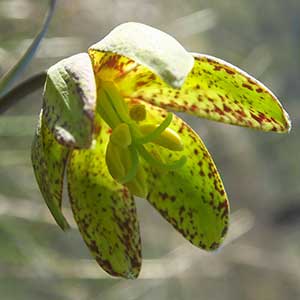Fritillaria glauca
Liliaceae
Siskiyou fritillary
lily family
5–20 cm.
underground or erect, scapose or leafy.
1–4(6), alternate, 3–11 cm long;
blades lance-ovate, sickleshaped, strongly glaucous.
1–many;
basal; cauline, or both, alternate, subopposite, or whorled, linear to ovate or square-shaped;
petioles short or absent.
solitary; panicles; racemes, or umbels.
cupshaped;
perianth segments oblanceolate to oblong, 1.5–2(2.5) cm long, yellow with purple mottling to purple with yellow mottling;
apex not recurved;
nectaries broad-lanceolate, 25-33% perianth segment length;
style branched for 50% its length.
radially symmetrical; erect or pendent;
perianth segments 6; distinct; in 2 petal-like whorls;
stamens 3 or 6;
ovary superior;
style 1;
stigmas entire or 3-lobed.
capsules winged.
capsules or berries.
flat or angled.
=24.
Fritillaria glauca
Liliaceae
Serpentine and non-serpentine gravelly slopes. Flowering Mar–Jun. 400–2100m. Casc, Sisk. CA. Native.
Fritillaria glauca is our only species that grows in serpentine soils. This species also grows in non-serpentine habitats. This begs the question: Was F. glauca historically a serpentine or non-serpentine endemic? The sickle-shaped and strongly glaucous leaves of F. glauca are distinct among Oregon fritillaries.
Cosmopolitan. 15 genera; 9 genera treated in Flora.
Due to taxonomic changes proposed by Stevens (2001), most genera formerly contained within Liliaceae have been placed in other families, most notably Amaryllidaceae and Asparagaceae.
Stephen Meyers
- Local floras:
CA,
OR
- Local Web sites:
CalFlora,
CalPhotos,
Flora NW,
PNW Herbaria
WildflowerSearch
iNaturalist (observations)
- LBJ Wildflower Center
- SEINet
- Plants of the World Online
- Encyclopedia of Life
- Wikipedia
- Google Image Search



